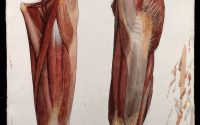Thoracic adaptations for ventilation during locomotion in humans and other mammals
Humans have evolved to have more endurance than power and speed. In contrast to other primates, humans are capable of sustained endurance activities such as trekking and running long distances over extended periods. Only a few other running-adapted mammals, such as dogs, wolves, and horses, are known to be capable of such sustained aerobic capacity.
Endurance running requires the ability to sustain aerobic metabolism over long distances by inspiring large air volumes for prolonged periods.
A study tested the general hypothesis that humans and other mammals selected for vigorous endurance activities evolved derived thoracic features to increase ventilatory capacity.
The study investigated whether humans and dogs rely on thoracic motion to increase tidal volume during running to a greater extent than goats, a species that was not selected for endurance locomotion.
The study found that all three species use diaphragmatic breathing to increase tidal volume with increasing oxygen demand. However, humans also use both dorsoventral and mediolateral expansion of the thorax. Dogs use increased dorsoventral expansion of the thorax, representing an intermediate between humans and goats.
3D analyses of joint morphology of 10 species across four mammalian orders also showed that endurance-adapted cursorial species independently evolved more concavo-convex costovertebral joint morphologies. This structure allows for increased rib mobility for thoracic expansion.
This evidence for similarly derived concavo-convex costovertebral joints in Homo erectus corresponds with other evidence for the evolution of endurance running.
Callison, W.É., Holowka, N.B. and Lieberman, D.E., 2019. Thoracic adaptations for ventilation during locomotion in humans and other mammals. Journal of Experimental Biology, 222(21).



